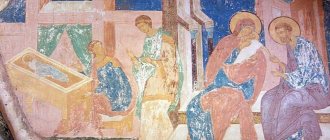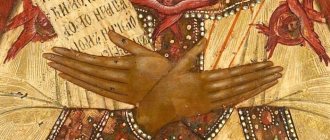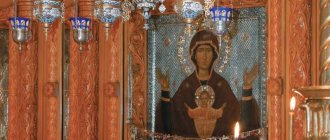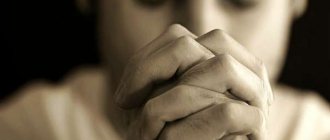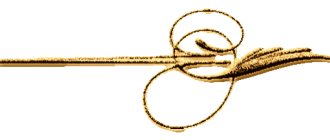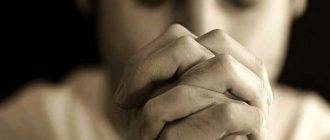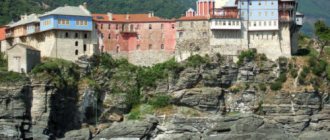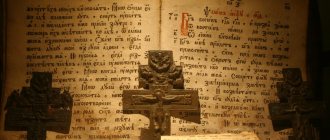The oldest surviving image of the Savior is the icon of the Savior of Sinai, which Emperor Justinian donated to the Sinai monastery in the 6th century, where it was discovered in the 19th century. Pantocrator is translated from Greek as Almighty.
The term "Almighty" expresses the dual nature of Jesus Christ - divine and human. The divinity of the Savior lies in the fact that He, the Son of the Lord and the Heavenly King, enters the Holy Trinity and becomes the Judge of the Last Judgment, before which each person will be held accountable for his actions. The human nature of the Savior is also expressed in the definition of “Almighty”, since, as the Messiah, he took upon himself the mission of saving humanity by sacrificing himself and accepting the martyr’s cross.
As history testifies, since ancient times the icon of Jesus Christ Pantocrator has been in most churches as the image of the Savior in all His power; the same image often became the theme for painting domes in both Orthodox and Catholic churches.
Description of the icon
Some canons in the iconographic image of Jesus Christ took shape already in the 9th century. On the icon of Christ Pantocrator, his image corresponds to the age when Jesus began his preaching. The appearance of the Savior has features characteristic of his time: shoulder-length hair, mustache, beard, but an extraordinary aura of strength, power and, at the same time, humanity emanates from his face.
In the icon, Jesus the Pantocrator is dressed, as a rule, in a long red tunic and draped over a blue himation, which should symbolize the harmony between his heavenly and earthly principles. True, this canon is not always observed: for example, on the icon of Andrei Rublev “The Savior in Power” Christ appears in golden royal robes.
The icon of the Almighty comes in three varieties: a full-length half-length image of the Savior seated on the royal throne, emphasizing his status as the King of Heaven; in his left hand he holds the Holy Scriptures, and his right is raised in a gesture of blessing.
Each element of the “Lord Pantocrator” icon is filled with deep meaning, including the addition of the fingers of the Savior’s right hand: two of them, raised, not only bless, but also symbolize His double hypostasis, human and divine, and three fingers joined together - the Holy Trinity: God Father, God the Son and the Holy Spirit.
LiveInternetLiveInternet
The “Christ Pantocrator” icon is the oldest image of Christ, which has miraculous power, heals and helps believers.
It is difficult for a true believer to imagine a church in which there is no icon of the Savior. The face of Christ is the adornment of every temple of God and a refuge for all lost and lost souls. Faith helps to improve life, strengthen the spirit, and feel the Higher Help, therefore, the true symbol of Christianity, imprisoned in the icon of “Christ Pantocrator”, should be found not only in every church, but also in every home.
History of the icon "Christ Pantocrator"
It is known that “Pantocrator” or “Pantocrator” is the main image of the Son of the Lord, written on icons. The holy image contains two faces of Jesus Christ, which is expressed in the form of a man and a deity. This image originated in ancient times, in Byzantium. One of the main oldest shrines that has survived to this day is the icon “Christ Pantocrator from the Sinai Monastery,” which dates back to the middle of the 6th century.
Not a single Orthodox church is complete without the image of the Savior; it is even unthinkable. The shrine adorns every Orthodox church and is the main element of the entire Christian faith. Since ancient times, believers from all over the world have offered their prayers before the icons of Christ Pantocrator, asking for help in troubles and misfortunes. The miraculous image of the Savior is still an important religious symbol to this day.
Where is the image of Christ located?
As you know, this image of the Savior can be found in every Christian church. The most famous icons are:
- In St. Petersburg, in the Church of the Savior on Spilled Blood;
- In Moscow, in the Church of the Nativity of John the Baptist;
- In Nizhny Novgorod, in the Church of St. Sophia.
The first and oldest icon of Christ Pantocrator from the Sinai monastery, which served as the origin of this type of iconography, is located in Egypt, in the monastery of St. Catherine.
Description of the icon of the Savior
The Savior on the iconographic shrine of the “Pantocrator” type is depicted in clothing typical of the ancient Greeks, which consists of a loose sleeveless shirt and an angular cape worn over it. The age of the Savior on the shrine corresponds to the years when He began to preach His teaching. Christ's straight hair falls to his shoulders. The fingers of His right hand are folded in a gesture symbolizing blessing, and in the other hand He holds a Bible. Holy Scripture can be either closed or open.
There are three types of icons depicting Christ Pantocrator, which have some differences: the Savior can be depicted at full height, waist-deep, and also sitting on the royal throne. All three faces of the Savior contain a certain meaning.
The meaning of the icon "Christ Pantocrator"
For many centuries, this type of iconography has been of great importance in Christianity. Icons of Christ Pantocrator serve as a reminder of repentance and forgiveness, as well as of the Judgment of God, which will affect every person.
The holy image does not leave believers without support, helping them cope with all sorrows and failures and take the path of a righteous life. The face of the Son of God on the Pantocrator icons is a symbol and reminder to all humanity of the unity of the material and spiritual, and at the same time of the suffering of Jesus, who sacrificed himself for the remission of human sins and their forgiveness.
How does the miraculous image of Jesus help?
The face of the Son of the Lord helps people achieve spiritual harmony, perseverance, and also find consolation in moments of grief and despair. Protects from bad intentions and deeds, heals mental and physical wounds, and serves as a talisman against misfortunes.
In front of the icon of Christ Pantocrator, Orthodox people pray with requests to protect them from deception and anger, from heartlessness and meanness. Christians also read words of gratitude to the Savior in their prayers, wanting to find His blessing in new endeavors.
The miraculous image of Christ Pantocrator is a powerful patron for families. It protects and protects children from diseases and misfortune. People suffering from even the most terrible and incurable diseases bow before the face of the Savior. It is believed that there is no disease of the soul and body that the Son of the Lord could not heal. But only he will find support and healing whose prayers before the sacred icon are devoid of pretense and bad thoughts, and their words are pure and sincere, coming from the depths of the heart and directed to Christ the Savior.
Days of celebration
The Russian Orthodox Church does not set aside an official day in honor of the celebration of this icon. In Christianity, it is generally accepted that the holy image of Christ Pantocrator does not need a special day for its celebration. This is due to the fact that Jesus, whose face is depicted on this type of iconography, is Himself the embodiment of Holiday, Happiness and Prosperity.
Prayer to Jesus Christ in front of His icon
Most often, the “Our Father” is read before the icon of Christ Pantocrator, but there are other prayers that are addressed to the miraculous image. One such prayer goes like this:
“Oh, Merciful and Mighty King of Heaven, Son of the Lord Jesus Christ! You sacrificed Your life, saving the human race from torment and suffering. Thank you, our Savior, for not leaving us in difficult moments. Hear our prayers, for we lift up our words to You! Do not leave us in sorrow and troubles, deliver us from anger and selfishness, give us will and perseverance. Heal from mental and physical illnesses. Guide us on the true path, forgive us our sins and give us Your blessing. We pray before Your most holy icon, You alone are our support and protection! Protect our children and our homes from enemies and adversity! Be near and do not leave us until the end of our days. We repent and ask forgiveness from You, Son of God, and from the Lord, Your Father, for all our sinful actions and thoughts. Deliver us from suffering and become our earthly patron! We will never cease to honor and glorify Your image! May we praise Your name, Son of the Lord, Jesus Christ! Let Your will be done. In the name of the Father, and the Son, and the Holy Spirit. Forever and ever. Amen".
From time immemorial, believers turned to the holy saints of God in the hope of a miracle, but anyone who at least once turned directly to Christ received help instantly. It has strength, faith and love. And his image is a parting word for people who want to live in righteousness and prosperity
What do they pray for in front of the icon of Christ Pantocrator?
Prayer in front of this icon helps to find spiritual harmony, strengthen constancy in faith, and consolation in difficult moments of life. The soul is cleansed by prayer from impurity and is directed to the true path, avoiding the path of evil. Prayer helps protect against evil machinations, deceptions and all sorts of troubles; helps to achieve not only spiritual harmony, but also harmony with the outside world and loved ones.
In the most difficult hour, you can turn to the icon of Christ Pantocrator with a prayer from a pure heart and receive consolation and resolution in a difficult life situation, whether it concerns your health, family relationships or problems with children, for the Lord is omnipotent and will answer your sincere prayer with your help .
The icon “Christ Pantocrator” does not have a special holiday, since Christ himself personifies the holiday.
Meaning of the icon
For Christians, the icon of “Christ Pantocrator” is a kind of symbol of the promise that justice and goodness will definitely triumph in the bright Kingdom of Heaven. It depicts Jesus in all his greatness and power.
With His appearance, He seems to remind every person that they need to live according to the commandments and renounce sinful deeds in order to be reunited with their Father at the end of their earthly journey.
Orthodox online store Svyatsy - Icons of Christ Pantocrator.
Prayer
Oh, Merciful and Mighty King of Heaven, Son of the Lord Jesus Christ! You sacrificed your life to save humanity from torture and suffering. Thank you, our Savior, for not leaving in difficult times. Hear our prayers as we lift up our words to You! Don’t leave us in pain and problems, get rid of anger and self-interest, give us will and resistance. Healing from mental and physical illnesses. Guide us on the right path, forgive us our sins and give us your blessing. Let us pray before Your Most Holy Icon, only you are our support and protection! Protect our children and our homes from enemies and adversity! Be near and do not leave us until the end of our days. We repent and ask forgiveness from You, the Son of God, and from the Lord, your Father, for all our sinful thoughts and actions. Free us from suffering and become our earthly patron! We will never cease to honor and extol your image! We can praise Your name, Son of the Lord, Jesus Christ! This will be done for everything. In the name of the Father and the Son and the Holy Spirit. Until the end of time. Amen.
Icon "Christ Pantocrator"
The “Christ Pantocrator” icon is the oldest image of Christ, which has miraculous power, heals and helps believers.
It is difficult for a true believer to imagine a church in which there is no icon of the Savior. The face of Christ is the adornment of every temple of God and a refuge for all lost and lost souls. Faith helps to improve life, strengthen the spirit, and feel the Higher Help, therefore, the true symbol of Christianity, imprisoned in the icon of “Christ Pantocrator”, should be found not only in every church, but also in every home.
History of the icon "Christ Pantocrator"
It is known that “Pantocrator” or “Pantocrator” is the main image of the Son of the Lord, written on icons. The holy image contains two faces of Jesus Christ, which is expressed in the form of a man and a deity. This image originated in ancient times, in Byzantium. One of the main oldest shrines that has survived to this day is the icon “Christ Pantocrator from the Sinai Monastery,” which dates back to the middle of the 6th century.
Not a single Orthodox church is complete without the image of the Savior; it is even unthinkable. The shrine adorns every Orthodox church and is the main element of the entire Christian faith. Since ancient times, believers from all over the world have offered their prayers before the icons of Christ Pantocrator, asking for help in troubles and misfortunes. The miraculous image of the Savior is still an important religious symbol to this day.
Where is the image of Christ located?
As you know, this image of the Savior can be found in every Christian church. The most famous icons are:
- In St. Petersburg, in the Church of the Savior on Spilled Blood;
- In Moscow, in the Church of the Nativity of John the Baptist;
- In Nizhny Novgorod, in the Church of St. Sophia.
The first and oldest icon of Christ Pantocrator from the Sinai monastery, which served as the origin of this type of iconography, is located in Egypt, in the monastery of St. Catherine.
Description of the icon of the Savior
The Savior on the iconographic shrine of the “Pantocrator” type is depicted in clothing typical of the ancient Greeks, which consists of a loose sleeveless shirt and an angular cape worn over it. The age of the Savior on the shrine corresponds to the years when He began to preach His teaching. Christ's straight hair falls to his shoulders. The fingers of His right hand are folded in a gesture symbolizing blessing, and in the other hand He holds a Bible. Holy Scripture can be either closed or open.
There are three types of icons depicting Christ Pantocrator, which have some differences: the Savior can be depicted at full height, waist-deep, and also sitting on the royal throne. All three faces of the Savior contain a certain meaning.
The meaning of the icon "Christ Pantocrator"
For many centuries, this type of iconography has been of great importance in Christianity. Icons of Christ Pantocrator serve as a reminder of repentance and forgiveness, as well as of the Judgment of God, which will affect every person.
The holy image does not leave believers without support, helping them cope with all sorrows and failures and take the path of a righteous life. The face of the Son of God on the Pantocrator icons is a symbol and reminder to all humanity of the unity of the material and spiritual, and at the same time of the suffering of Jesus, who sacrificed himself for the remission of human sins and their forgiveness.
How does the miraculous image of Jesus help?
The face of the Son of the Lord helps people achieve spiritual harmony, perseverance, and also find consolation in moments of grief and despair. Protects from bad intentions and deeds, heals mental and physical wounds, and serves as a talisman against misfortunes.
In front of the icon of Christ Pantocrator, Orthodox people pray with requests to protect them from deception and anger, from heartlessness and meanness. Christians also read words of gratitude to the Savior in their prayers, wanting to find His blessing in new endeavors.
The miraculous image of Christ Pantocrator is a powerful patron for families. It protects and protects children from diseases and misfortune. People suffering from even the most terrible and incurable diseases bow before the face of the Savior. It is believed that there is no disease of the soul and body that the Son of the Lord could not heal. But only he will find support and healing whose prayers before the sacred icon are devoid of pretense and bad thoughts, and their words are pure and sincere, coming from the depths of the heart and directed to Christ the Savior.
Days of celebration
The Russian Orthodox Church does not set aside an official day in honor of the celebration of this icon. In Christianity, it is generally accepted that the holy image of Christ Pantocrator does not need a special day for its celebration. This is due to the fact that Jesus, whose face is depicted on this type of iconography, is Himself the embodiment of Holiday, Happiness and Prosperity.
Prayer to Jesus Christ in front of His icon
Most often, the “Our Father” is read before the icon of Christ Pantocrator, but there are other prayers that are addressed to the miraculous image. One such prayer goes like this:
“Oh, Merciful and Mighty King of Heaven, Son of the Lord Jesus Christ! You sacrificed Your life, saving the human race from torment and suffering. Thank you, our Savior, for not leaving us in difficult moments. Hear our prayers, for we lift up our words to You! Do not leave us in sorrow and troubles, deliver us from anger and selfishness, give us will and perseverance. Heal from mental and physical illnesses. Guide us on the true path, forgive us our sins and give us Your blessing. We pray before Your most holy icon, You alone are our support and protection! Protect our children and our homes from enemies and adversity! Be near and do not leave us until the end of our days. We repent and ask forgiveness from You, Son of God, and from the Lord, Your Father, for all our sinful actions and thoughts. Deliver us from suffering and become our earthly patron! We will never cease to honor and glorify Your image! May we praise Your name, Son of the Lord, Jesus Christ! Let Your will be done. In the name of the Father, and the Son, and the Holy Spirit. Forever and ever. Amen".
From time immemorial, believers turned to the holy saints of God in the hope of a miracle, but anyone who at least once turned directly to Christ received help instantly. It has strength, faith and love. And his image is a parting word for people who want to live in righteousness and prosperity. We wish you peace in your soul, take care of yourself
History of the image
History has not preserved the exact date when the icon of Jesus Christ the Pantocrator was painted.
All that remains is evidence of its external appearance, the prototype of which was the Image of the Savior Not Made by Hands, glorified in the 4th century. It was during this period that several icons of the Lord were discovered in the catacomb churches. On them He was depicted as the Good Shepherd, the youth Emmanuel and even Orpheus. From the 4th century, icon painters began to paint Christ in the image of a radiant youth in white robes, surrounded by a host of apostles.
More about the icons of the Lord:
- Icon of the Holy Trinity
- Icon of the Exaltation of the Holy Cross
- How and when does the icon of Jesus Christ help?
And a little later, the Almighty is conveyed to us as an adult man with a long beard, holding a book in one hand, the other extended to the people in the gesture of an orator or preacher. Since the 5th century, Jesus has been depicted as a king.
The icon of the Almighty greatly outraged the heretics who did not recognize the divine essence of Christ. They considered Him an ordinary man upon whom the Holy Spirit had descended.
But the Ecumenical Councils, which affirmed the Orthodox doctrine, testified that Jesus Christ is the God-man of divine and human nature at the same time. He appeared into the world in the form of a man in order to, through His Life, heal humanity from sin and open the door to the Kingdom of Heaven.
In the 8th century, under the reign of Leo III the Isaurian, an iconoclast and heretic, Orthodox icons were actively destroyed, and Christians were imprisoned and subjected to terrible torture and execution. Soon, with God's help, the heretics were defeated and condemned at the VII Ecumenical Council. Since then, the icon of the Savior Almighty has become a symbol of the truth of the Orthodox faith.
In modern churches, the Image of Pantocrator is traditionally placed above the central dome of the temple and in the center of the iconostasis.
Lord Almighty. St. Vladimir's Cathedral in Kyiv
Ancient icon
The very first image is considered to be an icon from the Sinai Monastery. Christ is depicted in traditional vestments, seated on a throne with a pillow and stool at his feet.
The throne is an attribute of royal dignity. This is exactly how we will see the Savior on the Day of the Last Judgment, when He appears on the sinful earth in order to carry out the Judgment of God on the living and the dead.
In icon painting, there are several interpretations of the Almighty: Manuel the Savior, the Savior in Power, the Soul Savior, the Merciful.
Image of Jesus Christ Lord Almighty. Temple icon
